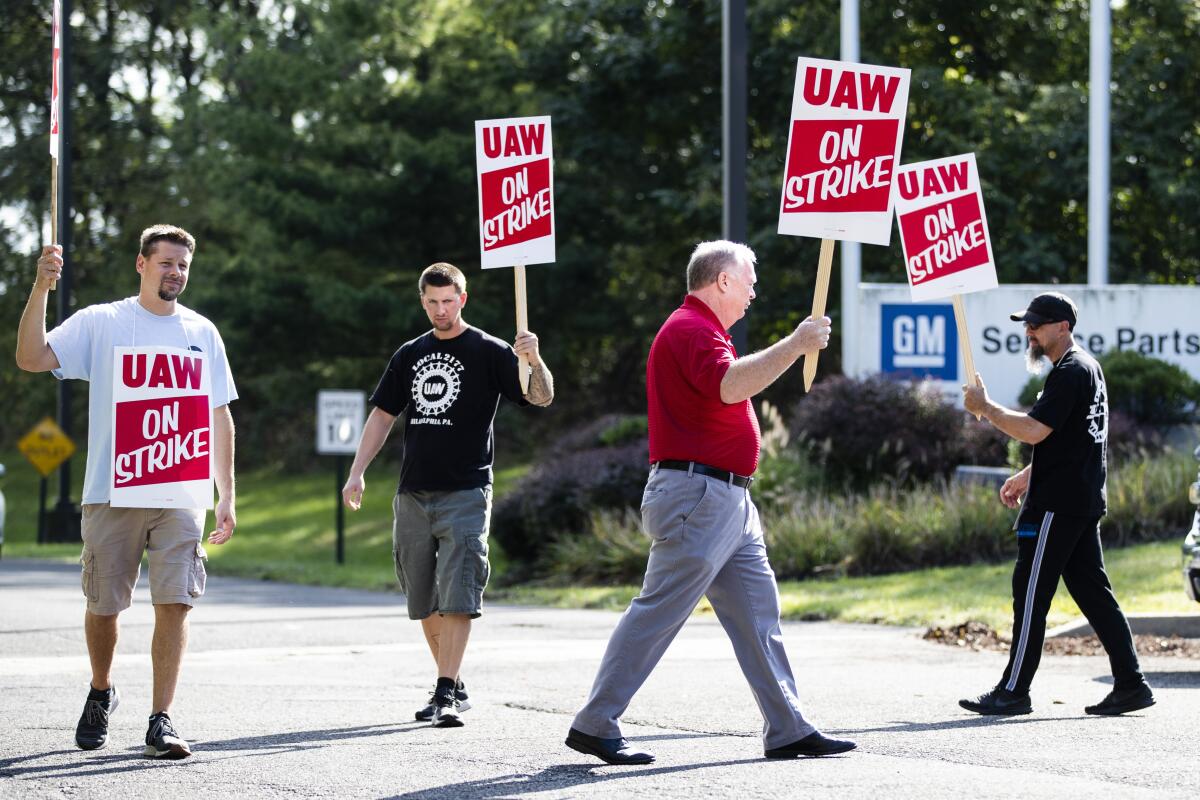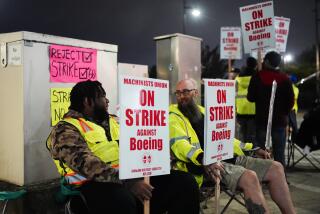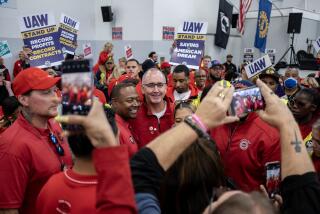GM strike idles more than 50 factories and warehouses

Detroit — More than 49,000 members of the United Auto Workers went on strike Monday against General Motors Co., bringing more than 50 factories and parts warehouses to a standstill in the union’s first walkout against the nation’s top automaker in more than a decade.
Workers left factories and formed picket lines shortly after midnight in the dispute over a new four-year contract. The union’s top negotiator said in a letter to GM that the strike could have been averted had the company made its latest offer sooner.
The letter, dated Sunday, suggests that the company and union are not as far apart as the rhetoric leading up to the strike had indicated. Negotiations resumed Monday in Detroit after breaking off during the weekend.
But union spokesman Brian Rothenberg said the two sides have come to terms on only 2% of the contract. “We’ve got 98% to go,” he said Monday.
Asked about the possibility of federal mediation, President Trump said it’s possible if the company and union want it.
“Hopefully they’ll be able to work out the GM strike quickly,” Trump said before leaving the White House for New Mexico. “Hopefully, they’re going to work it out quickly and solidly.”
Wall Street did not like seeing the union picketers. GM shares fell 4.2% on Monday to $37.21.
On the picket line Monday at GM’s transmission plant in Toledo, Ohio, workers who said they have been with the company for more than 30 years were concerned for younger colleagues who make less money under GM’s two-tier wage scale and have fewer benefits.
Paul Kane of South Lyon, Mich., a 42-year GM employee, said much of what the union is fighting for would not affect him.
“It’s not right when you’re working next to someone, doing the same job and they’re making a lot more money,” he said, adding that his lower-paid colleagues “should be the making the same as me. They’ve got families to support.”
Kane said GM workers gave up pay raises and made other concessions to keep GM afloat during its 2009 trip through bankruptcy protection.
“Now it’s their turn to pay us back,” he said. “That was the promise they gave.”
UAW Vice President Terry Dittes told GM that the company’s latest offer might have made it possible to reach an agreement had it arrived earlier.
“We are disappointed that the company waited until just two hours before the contract expired to make what we regard as its first serious offer,” Dittes said in the letter to Scott Sandefur, GM’s vice president of labor relations.
There are many important items left in the talks, including wage increases, pay for new hires, job security, profit sharing and treatment of temporary workers, Dittes’ letter said. “We are willing to meet as frequently, and for as long as it takes, to reach an agreement that treats our members fairly,” it said.
GM issued a statement saying it wants to reach a deal that builds a strong future for workers and the business.
The automaker said Sunday that it offered pay raises and $7 billion worth of U.S. factory investments resulting in 5,400 new positions, a minority of which would be filled by existing employees. GM would not give a precise number. The company also said it offered higher profit sharing, “nationally leading” health benefits and an $8,000 payment to each worker upon ratification.
Before the talks broke off, GM offered new products to replace work at two of four U.S. factories that it intends to close.
The company pledged to build a new all-electric pickup truck at a factory in Detroit, according to a person who was not authorized to disclose details of the negotiations and spoke on condition of anonymity.
The automaker also offered to open an electric vehicle battery plant in Lordstown, Ohio, where it has a huge factory that has already stopped making cars and will be closed. The new factory would be in addition to a proposal to make electric vehicles for a company called Workhorse, the person said.
It’s unclear how many workers the two plants would employ. The closures, especially of the Lordstown plant, have become issues in the 2020 presidential campaign. Trump has consistently criticized GM and demanded that the Lordstown plant be reopened.
Kristin Dziczek, vice president of labor and industry for the Center for Automotive Research, an industry think tank, called the letter and the resumption of contract talks encouraging signs. “It makes me think that both sides are probably closer than it might have seemed before,” she said.
But both Dziczek and Art Wheaton, an auto industry expert at the Worker Institute at Cornell University, said that GM left out key details when it made part of its offer public, and that working out those details could make the strike last longer.
“I think GM kind of sabotaged some of the negotiations by going immediately to the public,” Wheaton said. “It really distorts the offer.”
The strike shut down 33 manufacturing plants in nine states across the U.S., as well as 22 parts distribution warehouses. It’s the first national strike by the union since a two-day walkout in 2007 that had little effect on the company.
Workers at Fiat Chrysler and Ford continued working under contract extensions. Any agreement reached with GM would serve as a template for talks with the other two automakers.
If the U.S. strike lasts long enough, it is likely to stop GM from making vehicles in Canada and Mexico as well. That would mean fewer vehicles for consumers to choose from on dealer lots, and it would make it impossible to build specially ordered cars and trucks. Analysts at Cox Automotive said GM has enough vehicles at dealerships to last about 77 days at the current sales pace. That’s well above the industry average of 61. But supplies of the Chevrolet Tahoe and Suburban large SUVs, which generate big money for the company, are well below the industry average.
The labor talks this year have been overshadowed by a growing federal corruption probe that snared a top union official Thursday. Vance Pearson, head of a regional office based near St. Louis, was charged in an alleged scheme to embezzle union money and spend cash on premium booze, golf clubs, cigars and swanky stays in California. It’s the same region UAW President Gary Jones led before taking the union’s top office last year. Jones himself has been touched by the investigation, leading some union members to call for him to step down, but he has not been charged.
More to Read
Inside the business of entertainment
The Wide Shot brings you news, analysis and insights on everything from streaming wars to production — and what it all means for the future.
You may occasionally receive promotional content from the Los Angeles Times.










